Page 103 of 140
8-24
8 12. Install the seat.
TIPThe air filter element should be cleaned every 20–
40 hours. It should be cleaned more often if the
ATV is operated in extremely dusty areas. Each
time the air filter element maintenance is per-
formed, check the air inlet of the air filter case for
obstructions. Check the air filter case rubber joint
to the carburetor fittings and the rubber joint mani-
fold fittings for an air-tight seal. Tighten all fittings
securely to avoid the possibility of unfiltered air en-
tering the engine.EBU27082Cleaning the spark arrester Be sure the exhaust pipe and muffler are cool be-
fore cleaning the spark arrester.
1. Remove the tailpipe bolts.2. Remove the tailpipe by pulling it out of the
muffler.
3. Tap the tailpipe lightly, and then use a wire
brush to remove any carbon deposits from the
spark arrester portion of the tailpipe and inside
of the tailpipe housing.
1. Tailpipe bolt
2. Tailpipe
U1P066E0.book Page 24 Thursday, August 5, 2010 4:15 PM
Page 104 of 140
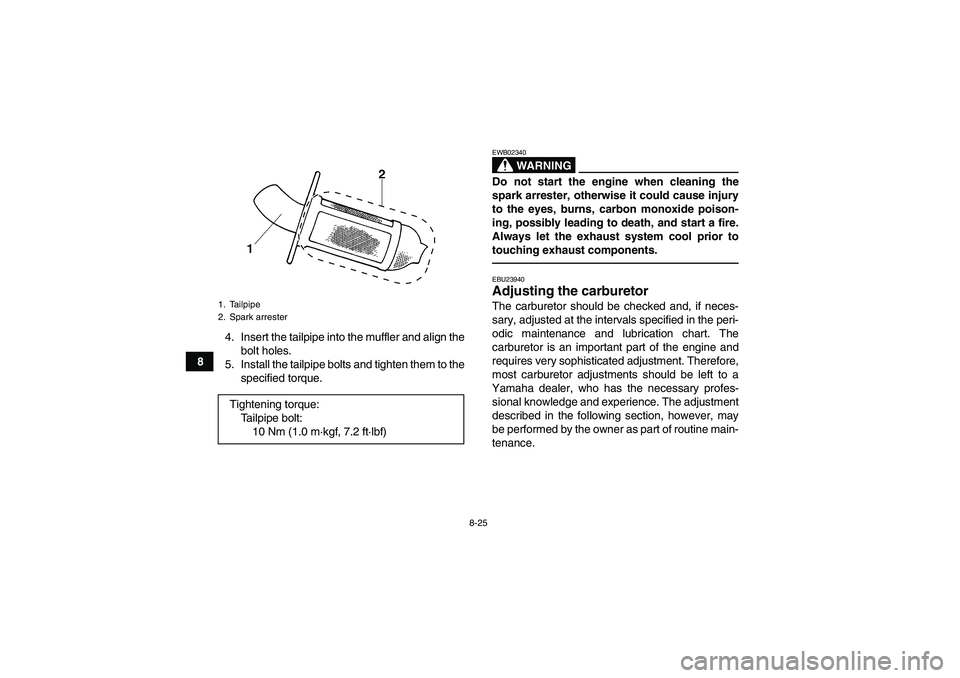
8-25
84. Insert the tailpipe into the muffler and align the
bolt holes.
5. Install the tailpipe bolts and tighten them to the
specified torque.
WARNING
EWB02340Do not start the engine when cleaning the
spark arrester, otherwise it could cause injury
to the eyes, burns, carbon monoxide poison-
ing, possibly leading to death, and start a fire.
Always let the exhaust system cool prior to
touching exhaust components.EBU23940Adjusting the carburetor The carburetor should be checked and, if neces-
sary, adjusted at the intervals specified in the peri-
odic maintenance and lubrication chart. The
carburetor is an important part of the engine and
requires very sophisticated adjustment. Therefore,
most carburetor adjustments should be left to a
Yamaha dealer, who has the necessary profes-
sional knowledge and experience. The adjustment
described in the following section, however, may
be performed by the owner as part of routine main-
tenance.
1. Tailpipe
2. Spark arresterTightening torque:
Tailpipe bolt:
10 Nm (1.0 m·kgf, 7.2 ft·lbf)
U1P066E0.book Page 25 Thursday, August 5, 2010 4:15 PM
Page 105 of 140
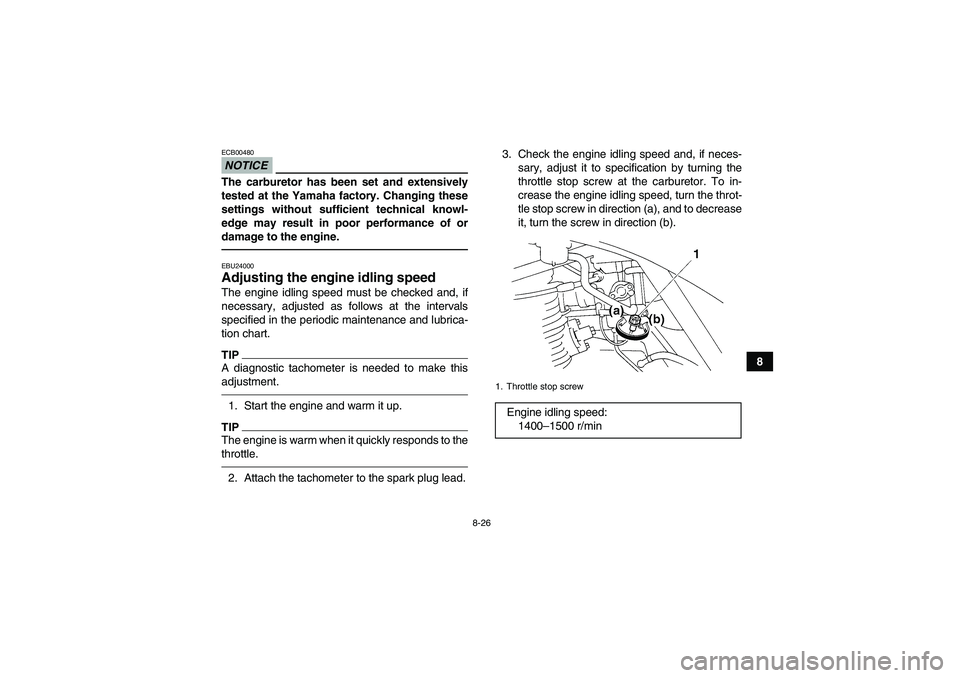
8-26
8
NOTICEECB00480The carburetor has been set and extensively
tested at the Yamaha factory. Changing these
settings without sufficient technical knowl-
edge may result in poor performance of or
damage to the engine.EBU24000Adjusting the engine idling speed The engine idling speed must be checked and, if
necessary, adjusted as follows at the intervals
specified in the periodic maintenance and lubrica-
tion chart.TIPA diagnostic tachometer is needed to make this
adjustment.1. Start the engine and warm it up.TIPThe engine is warm when it quickly responds to the
throttle.2. Attach the tachometer to the spark plug lead.3. Check the engine idling speed and, if neces-
sary, adjust it to specification by turning the
throttle stop screw at the carburetor. To in-
crease the engine idling speed, turn the throt-
tle stop screw in direction (a), and to decrease
it, turn the screw in direction (b).
1. Throttle stop screwEngine idling speed:
1400–1500 r/min
U1P066E0.book Page 26 Thursday, August 5, 2010 4:15 PM
Page 106 of 140
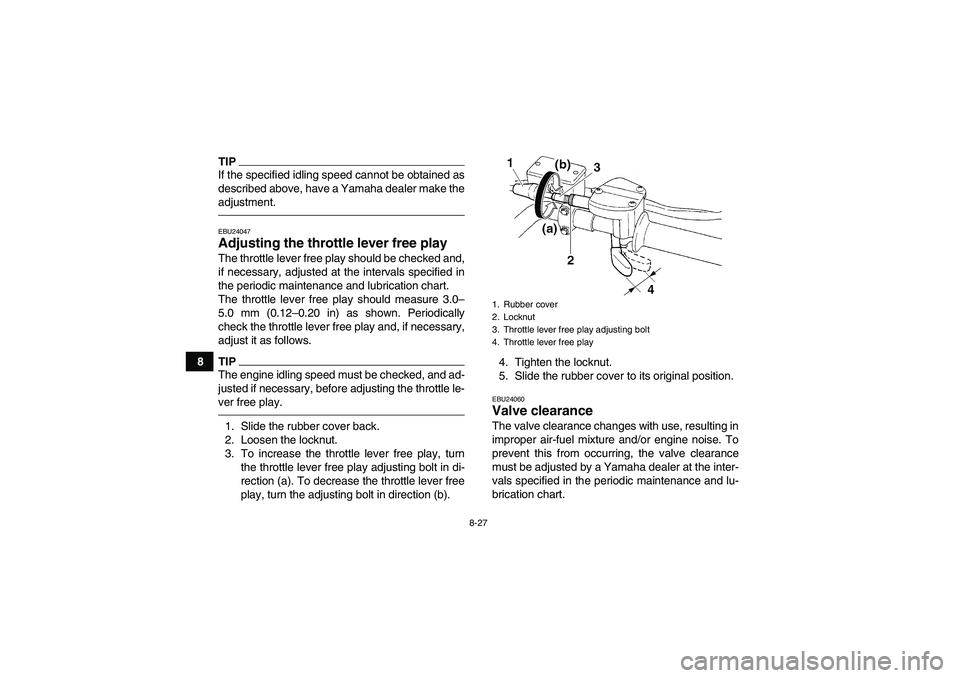
8-27
8
TIPIf the specified idling speed cannot be obtained as
described above, have a Yamaha dealer make the
adjustment.EBU24047Adjusting the throttle lever free play The throttle lever free play should be checked and,
if necessary, adjusted at the intervals specified in
the periodic maintenance and lubrication chart.
The throttle lever free play should measure 3.0–
5.0 mm (0.12–0.20 in) as shown. Periodically
check the throttle lever free play and, if necessary,
adjust it as follows.TIPThe engine idling speed must be checked, and ad-
justed if necessary, before adjusting the throttle le-
ver free play.1. Slide the rubber cover back.
2. Loosen the locknut.
3. To increase the throttle lever free play, turn
the throttle lever free play adjusting bolt in di-
rection (a). To decrease the throttle lever free
play, turn the adjusting bolt in direction (b).4. Tighten the locknut.
5. Slide the rubber cover to its original position.
EBU24060Valve clearance The valve clearance changes with use, resulting in
improper air-fuel mixture and/or engine noise. To
prevent this from occurring, the valve clearance
must be adjusted by a Yamaha dealer at the inter-
vals specified in the periodic maintenance and lu-
brication chart.1. Rubber cover
2. Locknut
3. Throttle lever free play adjusting bolt
4. Throttle lever free play
U1P066E0.book Page 27 Thursday, August 5, 2010 4:15 PM
Page 110 of 140
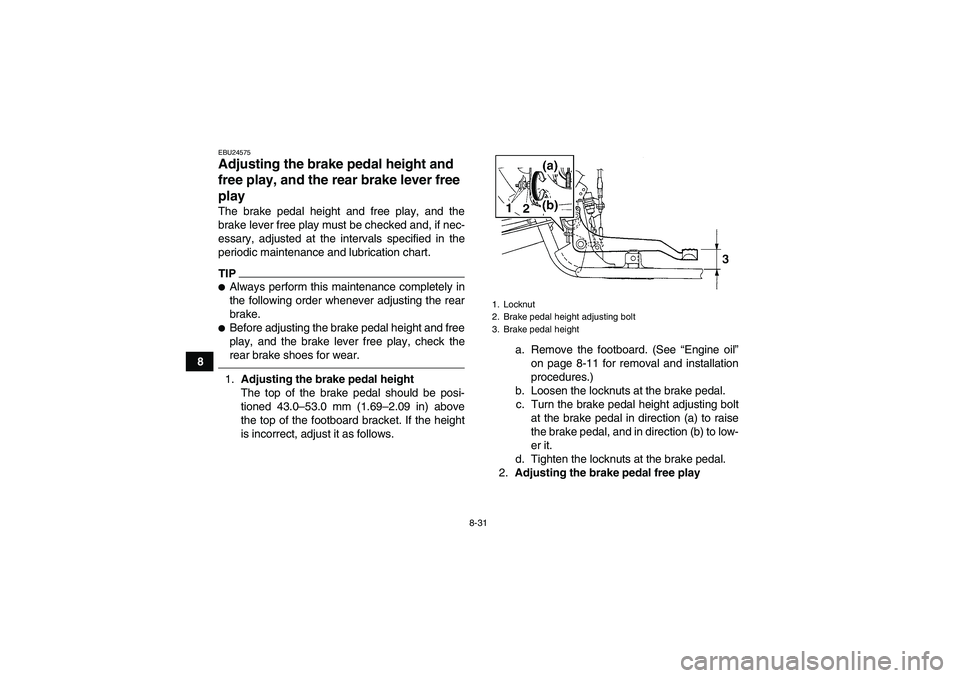
8-31
8
EBU24575Adjusting the brake pedal height and
free play, and the rear brake lever free
play The brake pedal height and free play, and the
brake lever free play must be checked and, if nec-
essary, adjusted at the intervals specified in the
periodic maintenance and lubrication chart.TIP�Always perform this maintenance completely in
the following order whenever adjusting the rear
brake.�Before adjusting the brake pedal height and free
play, and the brake lever free play, check the
rear brake shoes for wear.1.Adjusting the brake pedal height
The top of the brake pedal should be posi-
tioned 43.0–53.0 mm (1.69–2.09 in) above
the top of the footboard bracket. If the height
is incorrect, adjust it as follows.a. Remove the footboard. (See “Engine oil”
on page 8-11 for removal and installation
procedures.)
b. Loosen the locknuts at the brake pedal.
c. Turn the brake pedal height adjusting bolt
at the brake pedal in direction (a) to raise
the brake pedal, and in direction (b) to low-
er it.
d. Tighten the locknuts at the brake pedal.
2.Adjusting the brake pedal free play
1. Locknut
2. Brake pedal height adjusting bolt
3. Brake pedal height
U1P066E0.book Page 31 Thursday, August 5, 2010 4:15 PM
Page 114 of 140
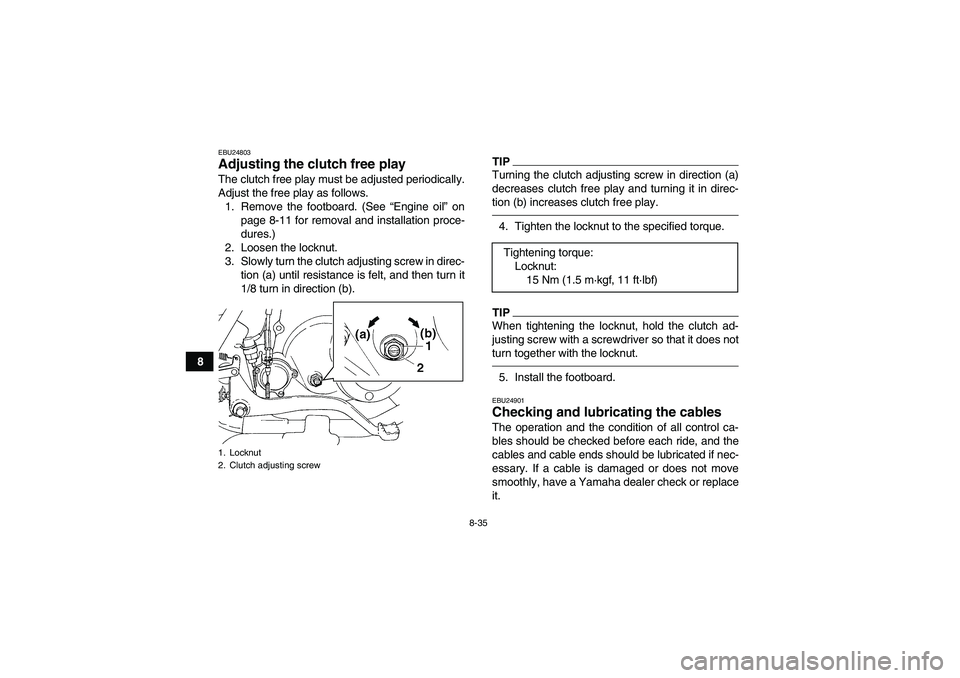
8-35
8
EBU24803Adjusting the clutch free play The clutch free play must be adjusted periodically.
Adjust the free play as follows.
1. Remove the footboard. (See “Engine oil” on
page 8-11 for removal and installation proce-
dures.)
2. Loosen the locknut.
3. Slowly turn the clutch adjusting screw in direc-
tion (a) until resistance is felt, and then turn it
1/8 turn in direction (b).
TIPTurning the clutch adjusting screw in direction (a)
decreases clutch free play and turning it in direc-
tion (b) increases clutch free play.4. Tighten the locknut to the specified torque.TIPWhen tightening the locknut, hold the clutch ad-
justing screw with a screwdriver so that it does not
turn together with the locknut.5. Install the footboard.EBU24901Checking and lubricating the cables The operation and the condition of all control ca-
bles should be checked before each ride, and the
cables and cable ends should be lubricated if nec-
essary. If a cable is damaged or does not move
smoothly, have a Yamaha dealer check or replace
it.
1. Locknut
2. Clutch adjusting screw
Tightening torque:
Locknut:
15 Nm (1.5 m·kgf, 11 ft·lbf)
U1P066E0.book Page 35 Thursday, August 5, 2010 4:15 PM
Page 115 of 140
8-36
8
WARNING
EWB02581�Inspect cables frequently and replace if dam-
aged. Corrosion can result when the cable
sheaths become damaged, and cables can
also become frayed or kinked, which could
restrict the operation of controls and lead to
an accident or injury.�Always make sure all control cables work
smoothly before you begin riding in cold
weather. If the control cables are frozen or do
not work smoothly, you could be unable to
control the ATV, which could lead to an acci-
dent or collision.EBU28711Checking and lubricating the front and
rear brake levers The operation of the front and rear brake levers
should be checked before each ride, and the lever
pivots should be lubricated if necessary.Front brake lever Recommended lubricant:
Engine oil
Recommended lubricants:
Front brake lever:
Silicone grease
Rear brake lever:
Lithium-soap-based grease
U1P066E0.book Page 36 Thursday, August 5, 2010 4:15 PM
Page 116 of 140
8-37
8Rear brake lever
EBUM0170Checking the shift pedal The operation of the shift pedal should be checked
before each ride. If operation is not smooth, have
a Yamaha dealer check the vehicle.EBU30310Checking and lubricating the brake
pedal The operation of the brake pedal should be
checked before each ride, and the pedal pivot
should be lubricated if necessary.
TIPTo access the brake pedal pivot, remove the foot-
board. (See “Engine oil” on page 8-11 for removal
and installation procedures.)EBU24963Checking the wheel hub bearings The front and rear wheel hub bearings must be
checked at the intervals specified in the periodic
maintenance and lubrication chart. If there is playRecommended lubricant:
Lithium-soap-based grease
U1P066E0.book Page 37 Thursday, August 5, 2010 4:15 PM